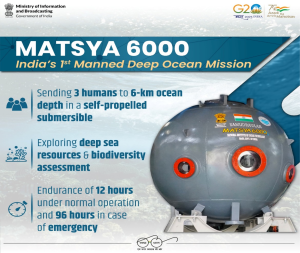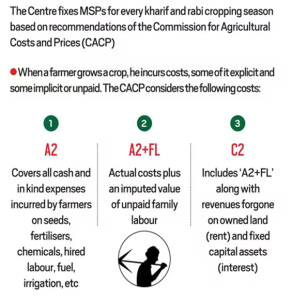Mains – 10th Nov 23
India’s Deep Ocean Mission
Why in News?
India is preparing for a groundbreaking Deep Ocean Mission, aiming to delve into and tap into the unexplored depths of the ocean—a realm that brims with scientific possibilities and promising economic opportunities
- Countries such as theS.A., Russia, China, France, and Japanhave already achieved successful deep-ocean crewed missions.
What is the Deep Ocean Mission?
- About:
- Deep Ocean Mission (DOM) is an ambitious initiative of the Ministry of Earth Sciences (MoES) which aims to develop technologies and capabilities for deep sea exploration.
- Also, DOM is one of nine missions under thePMSTIAC (Prime Minister’s Science, Technology and Innovation Advisory Council).
- Pillars of the Mission: DOM, Principally led by MoES, consists of 6 pillars
- Innovations forDeep-Sea Biodiversity Exploration and Conservation
- Technological Advancements for Deep-Sea Miningand Crewed Submersibles exploring depth up to 6,000 meters.
- Survey and Exploration of Deep-Ocean Minerals
- Ocean Climate Change Advisory Services
- Harvesting Energy and Freshwater from the Ocean
- Establishment of anAdvanced Marine Station for Ocean Biology
- Major Advancement in DOM Objectives:
- SAMUDRAYAAN and MATSYA6000: As a part of DOM, India’s flagship deep ocean mission, Samudrayaan,was initiated in 2021 by the Minister of Earth Sciences.
- With Samudrayaan, India is embarking on a groundbreaking crewed expedition to reach a depth of6,000 m to the ocean bed in the Central Indian Ocean.
- This historic journey will be accomplished by Matsya6000, a deep-ocean submersibledesigned to accommodate a crew of three members.
- It is constructed from a titanium alloy, the sphere is engineered to withstand pressures of up to 6,000 bar.
- SAMUDRAYAAN and MATSYA6000: As a part of DOM, India’s flagship deep ocean mission, Samudrayaan,was initiated in 2021 by the Minister of Earth Sciences.
- Deep Ocean Mission (DOM) is an ambitious initiative of the Ministry of Earth Sciences (MoES) which aims to develop technologies and capabilities for deep sea exploration.

Note
The decision to target a depth of 6,000 meters holds strategic importance due to the presence of valuable resources like polymetallic nodules and sulphides. These resources, containing essential metals, are found between depths of 3,000 to 5,500 meters.
- Varaha- India’s Deep-Ocean Mining System:The National Institute of Ocean Technology, an autonomous institute under MoES has conducted successful deep-sea locomotion trials using ‘Varaha,’ an underwater mining system, at a depth of 5,270 meters in the central Indian Ocean.
What are the Major Challenges in Deep Ocean Exploration?
- Oceanic Pressure Challenges:The high-pressure conditions in the deep ocean present a formidable challenge, exerting immense pressure on objects comparable to carrying a weight of about 10,000kg per square meter.
- Equipment Design and Functionality:The harsh conditions necessitate meticulously designed equipment made from robust materials. Electronics and instruments operate more efficiently in space or vacuum conditions, while poorly designed objects tend to collapse or explode underwater.
- Challenges of Landing:The soft and muddy surface of the ocean bed makes it exceptionally challenging for heavy vehicles to land or maneuver.
- Material Extraction and Power Demands: Extracting materials from the ocean floor requires significant power and energyto pump them to the surface.
- Remotely operated vehicles are ineffective in the deep oceans due to the absence of electromagnetic wave propagation.
- Visibility is limited,with natural light penetrating only a few tens of meters underwater, unlike space observations facilitated by telescopes.
- Other Compounded Challenges:Varied factors such as temperature variations, corrosion, salinity, and others further complicate deep-sea exploration, demanding comprehensive solutions.
Way Forward
- Biologically-Inspired Designs: Draw inspiration from nature, such as marine organisms, for innovative engineering solutions.
- Biomimicrycould lead to the development of structures and materials that are naturally suited to deep-sea conditions, offering increased resilience and adaptability.
- Energy Innovation:Develop sustainable power sources to support long-duration missions.
- This could include advancements in energy harvesting technologies likeocean thermal energy conversion, utilizing temperature gradients in the ocean for power, or exploring the potential of tidal and wave energy.
- Multi-Sensor Integration:Integrate diverse sensor technologies to compensate for limited visibility.
- This could involve combining sonar, lidar, and other imaging technologies to create a comprehensive pictureof the deep-sea environment, allowing for better navigation and exploration.
- Environmental Impact Consideration:Ensuring that exploration initiatives are conducted with minimal impact on deep-sea ecosystems.
- Establishing international regulations and policies that govern deep-sea explorationto ensure responsible and ethical practices, balancing scientific advancement with environmental conservation.
Open Market Sale Scheme
Why in news?
States have been looking at alternative ways of procuring wheat and rice in the aftermath of the Food Corporation of India’s (FCI) quantity restrictions followed by the refusal to allow states to procure the two food grains through its Open Market Sale Scheme (OMSS).
Open Market Sale Scheme
- At first, procurement of food grains like wheat and paddy for the central pool happens in Rabi and Kharif marketing seasons by the FCI and State corporations according to procurement estimates finalised by the government of India before the seasons. These purchases happen as per the Minimum Support Price.
- From the central pool, the government has to set aside wheat and rice for the 80 crore beneficiaries of free foodgrains under the National Food Security Act (NFSA), maintain a buffer stock, and have a marketable surplus.
- Under the Open Market Sale Scheme, the FCI from time to time sells (through e-auctions) surplus food grains from the central pool especially wheat and rice in the open market to traders, bulk consumers, retail chains and so on at pre-determined prices. This is done to enhance the supply of grains especially during the lean season and thereby to moderate the general open market prices especially in the deficit regions.
- Usually, states are also allowed to procure food grains through the OMSS without participating in the auctions, for their needs beyond what they get from the central pool to distribute to NFSA beneficiaries.
Recent Changes
- The OMSS underwent a recent revision with a focus on limiting the quantity that a single bidder can purchase in a single bid.
- Previously, the maximum allowed quantity per bid was 3,000 metric tonnes. However, it has now been reduced to a range of 10-100 metric tonnes.
- The aim of this change is to promote wider participation by accommodating small and marginal buyers.
Discontinuation of OMSS Sales to States:
- The Centre decided to discontinue the sale of rice and wheat from the central pool to state governments under the OMSS.
- Additionally, private bidders are no longer allowed to sell their OMSS supplies to states.
- The rationale behind this decision is to control inflationary trends and maintain adequate stock levels in the central pool.
- Karnataka and Tamil Nadu have criticized the Centre’s decision.
| The MSP is the rate at which the government purchases crops from farmers, and is based on a calculation of at least one-and-a-half times the cost of production incurred by the farmers.
MSP for a crop is the price at which the government is supposed to procure/buy that crop from farmers if the market price falls below it. The Commission for Agricultural Costs & Prices (CACP) recommends MSPs for 22 mandated crops and fair and remunerative price (FRP) for sugarcane. The mandated crops include 14 crops of the kharif season, 6 rabi crops and 2 other commercial crops. Crops covered by MSPs include: · 7 types of cereals (paddy, wheat, maize, bajra, jowar, ragi and barley), · 5 types of pulses (chana, arhar/tur, urad, moong and masur), · 7 oilseeds (rapeseed-mustard, groundnut, soyabean, sunflower, sesamum, safflower, nigerseed), · 4 commercial crops (cotton, sugarcane, copra, raw jute) Who decides the MSP? The MSPs are announced by the Union government but its decision on the recommendations of the Commission for Agricultural Costs and Prices (CACP). The Cabinet Committee on Economic Affairs (CCEA) of the Union government takes a final decision on the level of MSPs and other recommendations made by CACP. MSPs have no statutory backing — a farmer cannot demand MSP as a matter of right. While recommending MSPs, the CACP looks at the following factors: · the demand and supply of a commodity; · its cost of production; · the market price trends (both domestic and international); · inter-crop price parity; · the terms of trade between agriculture and non-agriculture (that is, the ratio of prices of farm inputs and farm outputs); · a minimum of 50 per cent as the margin over the cost of production; and · the likely implications of an MSP on consumers of that product. · CACP reckons only A2+FL cost for return. · However, C2 costs are used by CACP primarily as benchmark reference costs (opportunity costs) to see if the MSPs recommended by them at least cover these costs in some of the major producing States. |

National Food Security Act 2013
- From welfare based approach to rights based approach.
- 75% rural + 50% urban i.e. 67% of population covered.
- Subsidized food grain – rice @3, wheat @2, coarse grains @1
Food Corporation of India
- FCI is a statutory body set up in 1965 under the Food Corporations Act of 1964. It was established against the backdrop of a major shortage of grains, especially wheat.
- The FCI manages the food security system in India.
- The FCI also maintains buffer stocks of food grains to ensure food security during times of scarcity or crisis.
- The FCI is also responsible for distributing foodgrains throughout the country for the public distribution system.
- FCI also conducts e-auction as one of the methods to dispose of its surplus food grains
